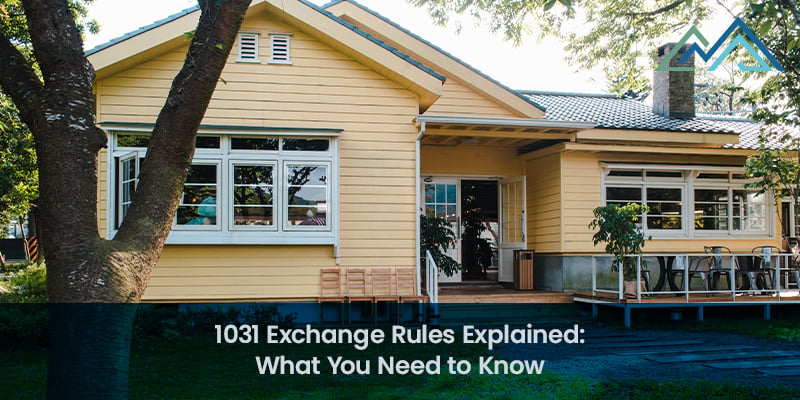Capital gains taxes can add up quickly if you’re not careful. While it may not be possible to avoid paying all capital gains tax, there are things you can do to reduce your tax liability through tax planning, so you can keep more of your money. One strategy that can help is a 1031 exchange.
At CMP, we work with high-income clients to help them avoid overpaying taxes, which can be an important part of wealth management and financial planning. If you want to use a 1031 exchange to reduce your capital gains taxes, it’s essential to understand the rules. Keep reading to learn how to defer your taxes with replacement properties in a like-kind exchange.

Types of 1031 Exchanges
A 1031 exchange, also known as a like-kind exchange, involves reinvesting the capital gains from one investment into a new investment of the same kind. You should be aware of four types of 1031 exchanges, each with its specifications.
1. Simultaneous 1031 Exchange
A simultaneous exchange means two (or sometimes three) parties exchange assets. Coordinating the exchanges means that no taxable event takes place.
2. Delayed 1031 Exchange
This is the most common type of 1031 exchange. It involves selling one asset and designating a 3rd party to hold the capital gains for a maximum of 45 days. You must acquire the new asset using capital gains to defer tax payments during that period.
3. Reverse 1031 Exchange
The reverse 1031 exchange is the opposite of a delayed exchange. You would need to acquire your new property through an exchange accommodation titleholder since you can’t take advantage of the exchange if you own both properties simultaneously.
4. Construction or Improvement 1031 Exchange
If you want to buy a property that doesn’t exactly suit your needs, an improvement exchange can help. You’ll need an exchange accommodation titleholder. All deferred capital gains must be used for renovations, completed within 180 days of the purchase.
While many of these exchanges are possible, the delayed 1031 exchange is the most common and the one you’re most likely to use.
Understanding Like-Kind Property
Understanding the definition of like-kind property is necessary before undertaking a 1031 exchange. Here’s the definition from the IRS website.
Properties are of like-kind if they’re of the same nature or character, even if they differ in grade or quality. Real properties generally are of like-kind, regardless of whether they’re improved or unimproved. For example, an apartment building would typically be like-kind to another apartment building.
The one exception is that the IRS doesn’t consider foreign properties to be like-kind to domestic properties.
Reporting a Like-Kind Exchange
The IRS requires taxpayers to complete and file Form 8824, Like-Kind Exchanges, for each property involved in a 1031 exchange. You must include this information when you file your tax return.
- Description of the like-kind property being acquired
- Description of the like-kind property being given up
- Dates of property acquisition or transfer
- Names of intermediaries
You can find full instructions to complete Form 8824 here.
Examples of Qualifying Properties for a 1031 Exchange
1031 exchanges are restricted to property held for investment or for productive use in a trade or business. Here are some examples of properties that might qualify.
- Single-family homes
- Apartment buildings
- Commercial buildings
- Vacant lots
- Farmland
In some cases, you may be able to turn one of your rental properties into your primary residence, but there are limitations. If you’re not sure if your property qualifies, work with an experienced tax professional.
Identifying Potential Replacement Properties
Here are a few requirements to remember when identifying potential replacement properties for a 1031 exchange.
- Properties must be of equal or greater value
- The entire proceeds of the sale must be used to purchase the second property
- You may not use the proceeds from the sale of a building to buy stock – the “like-kind” part is very important
When in doubt, make sure to check with a qualified tax professional. You do not want to leave any questions about qualifications. If you do, you could be on the hook for capital gains tax plus fees and penalties.
Qualified Intermediaries and Their Role in the Exchange Process
Qualified intermediaries play an essential part in 1031 exchanges. Their first purpose is to establish a chain of events that tells the IRS that a taxpayer intends to take advantage of a 1031 exchange.
Their second job is to create an escrow account with a financial institution to hold the funds involved in a 1031 exchange until the transaction can be completed in accordance with the rules for like-kind exchanges.
Note that in a simultaneous two-party 1031 exchange, a qualified intermediary is not required. Your sales agreements and other documentation will prove to the IRS that you’ve made a legal 1031 exchange. Note that you’ll still need to pass funds through an escrow account to be sure no taxable event occurs.
Timeframes and Deadlines in a 1031 Exchange
Any type of 1031 exchange has its own rules regarding how long it takes to buy and sell properties and complete the exchange.
- For a simultaneous exchange, you’ll have 45 days to identify a qualifying replacement and 180 days to complete the exchange.
- For a delayed exchange, you’ll have 45 days to identify a qualifying replacement property and 180 days to complete the 1031 exchange.
- For a reverse exchange, you’ll have 45 days to declare the real estate you sold as relinquished property and 135 days to complete the sale and the related 1031 exchange.
- For an improvement exchange, you must declare your property relinquished within 45 days, and all improvements must be completed within 180 days to qualify for the 1031 exchange.
The rules aren’t complicated, but the timing is important if you want to qualify for an exchange.
Tax Implications and Benefits of a 1031 Exchange
Here are some of the tax benefits and implications of a 1031 exchange.
You’ll defer capital gains tax payments
In theory, you can defer capital gains taxes for your lifetime, but you should keep in mind that your heirs may be stuck with the bill.
You can trade up for more valuable properties
Provided you don’t need your capital gains for other purposes, it’s easy to swap one property for another to build your real estate holdings.
You can reset your depreciation
Depreciation can help you reduce the taxes you owe by allowing for a reduction in value thanks to wear and tear on your property. When you buy a new property, you reset your depreciation.
You can diversify your portfolio
If you’re not already invested in real estate, buying property and using 1031 exchanges can help you balance your risk.
Funds must be held by a third party
Even if you don’t use a qualified intermediary, you still need to put funds in escrow to avoid a taxable event taking place.
In short, 1031 exchanges can help you minimize your tax burden while diversifying your holdings.
Frequently Asked Questions about 1031 Exchanges
How do I get started in a 1031 exchange?
The easiest way to get started is to identify both the property you’re relinquishing and the property you’re buying. Then, hire a Qualified Intermediary. While you might not need an intermediary in every case, using one can help you avoid costly errors.
What are the guidelines for a related party transaction?
A related party transaction occurs between two parties with a pre-existing business relationship. If your 1031 exchange is a related party transaction, you must adhere to Financial Accounting Standards Board rules. These include payment terms, monitoring of payment competitiveness, and monitoring of transactions and authorized expenses. We strongly recommend working with a tax professional, such as CMP, to ensure you’re not violating any related party rules.
What information is needed to structure a 1031 exchange?
You need only a few pieces of information to structure a 1031 exchange. These include:
- The name, address, and phone number of the Exchanger
- The escrow officer’s name, address, phone number, and escrow number
Providing additional information may be helpful. For example, you should know:
- What property is being relinquished
- When it was acquired
- How much you paid for it
- How the property was used during ownership
- If a sale is pending and if it is, the closing date
- The value, equity, and mortgage of the property
- Which property you would like to acquire
- The purchase price
Get Help with a 1031 Exchange
Carrying out a 1031 exchange is advantageous because you can defer capital gains tax and diversify your portfolio simultaneously. The guidance we’ve provided here can help you navigate the process and take full advantage of like-kind exchanges.
Do you need assistance with a 1031 exchange? CMP can help.

















